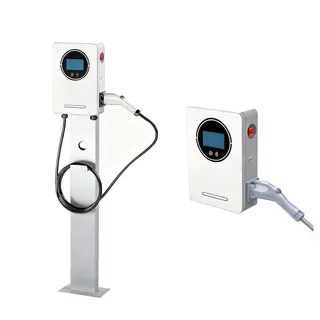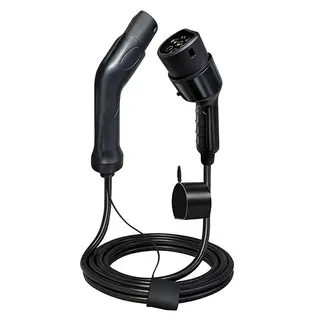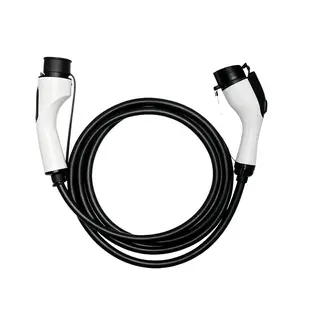With the increasing popularity of electric vehicles (EVs), more and more car owners are considering how to charge their vehicles more conveniently. Installing a home electric vehicle charger has become an increasingly popular solution. This charging method not only provides the convenience of charging at home but also reduces dependence on public charging infrastructure. However, any technological advancement has its pros and cons, and home electric vehicle chargers are no exception. Before making an installation decision, consumers need to carefully weigh various factors.
A home electric vehicle charger, also known as electric vehicle supply equipment (EVSE), is a device installed at home for charging electric vehicles (EVs). It typically includes a charging device connected to the home power supply and an electric vehicle connector. According to different charging speeds and connection methods, home electric vehicle chargers are mainly divided into two categories: Level 1 chargers and Level 2 chargers.
Level 1 chargers are the most basic home charging devices. They can be directly plugged into a standard household outlet (usually 120 volts), providing a slower charging speed. This type of charger is suitable for car owners who do not require fast charging. For example, if your daily commuting distance is short, a Level 1 charger can fully charge your vehicle overnight.
Level 2 chargers need to be connected to a dedicated 240-volt circuit and provide faster charging speeds. This type of charger is suitable for those who require rapid charging, such as when your commuting distance is long or your vehicle has a large battery capacity. In addition, Level 2 chargers usually also feature some innovative functions, such as charging scheduling and monitoring capabilities, as well as safety functions.
The popularity of home electric vehicle chargers has brought many real benefits to car owners. These advantages not only improve convenience in daily use but also offer long-term economic and environmental benefits. The following will elaborate on the main advantages of home electric vehicle chargers.
The greatest advantage of installing a home electric vehicle charger is its convenience. If you have a home electric vehicle charger, you can easily allow your vehicle to charge at night, and when you wake up, the battery is already fully charged. This eliminates the trouble of searching for public charging stations, waiting in line, and the inconvenience of having to go out just to charge the vehicle. Imagine that after a busy day, you simply park your car in the garage, plug in the charging cable, and you can rest peacefully.
Charging an electric vehicle at home is usually much cheaper than using public charging stations. Public charging stations may charge a higher per-kilowatt-hour rate and may even require membership fees. By charging at home, you can take advantage of lower electricity costs, especially during off-peak hours, further reducing the overall charging cost. For example, if your vehicle needs 10 kWh of electricity every day, using a public charging station may cost more than 10 yuan, while charging at home may only cost about 5 yuan.
Installing a home electric vehicle charger can also help reduce your carbon footprint. If you use renewable energy such as solar panels or choose a green energy provider, even if home charging still requires connection to the power grid to obtain electricity, it can significantly reduce the negative environmental impact caused by charging the vehicle. For example, if solar panels are installed at your home, you can use solar energy to charge your vehicle, which not only reduces dependence on traditional energy sources but also lowers carbon emissions.
Home electric vehicle chargers, especially smart chargers, can enhance flexibility and control during the charging process. With functions such as scheduled charging, you can optimize charging sessions to take advantage of off-peak electricity rates or ensure that your vehicle is fully charged before a trip begins. For example, if your vehicle needs to leave at 7 a.m., you can set the charger to start charging at 2 a.m., so charging takes place during the lowest electricity price period while ensuring the vehicle is fully charged before departure.
Installing a home electric vehicle charger is a key step in achieving convenient charging. This process involves several important steps, including selecting appropriate equipment, determining the installation location, ensuring safety and compliance, and more. The following are the detailed steps and points to note when installing a home electric vehicle charger.
Most electric vehicle (EV) drivers, including battery electric vehicles and plug-in hybrid electric vehicles (PHEVs), charge their vehicles at night using home AC Level 1 or AC Level 2 charging equipment. Home electric vehicle chargers are typically installed in a garage, but outdoor installation and use are equally safe. Even charging your vehicle on a rainy day is not a problem as long as the equipment used is rated for outdoor use.
Charging installation in multi-family residential housing requires additional considerations. This type of charging is more similar to public charging rather than private charging at a single-family home. For example, when installing a charger in an apartment building, it is necessary to consider how to allocate charging equipment and how to manage charging time.
Electric vehicle owners can install Level 2 (240V) charging equipment at home to achieve faster charging speeds or choose to use the Level 1 charging cable that comes with the vehicle. If there is a dedicated power outlet near the parking location, many EV owners can meet their daily driving mileage by charging overnight with Level 1 charging equipment without additional costs or installation.
For vehicles with longer commuting distances, irregular schedules, or larger battery capacities that require longer charging time, Level 2 charging equipment may be chosen. Some state governments and utility companies also offer incentive measures to help offset installation costs.
Most Level 2 charging products come with standard safety features and status indicator lights. More advanced “smart” Level 2 devices also come equipped with data collection, user interface, enhanced display, charging timer, communication capabilities, and keypad input. It is recommended to purchase equipment with safety certifications, such as those with ENERGY STAR labels and tested by nationally recognized testing laboratories, and ensure installation is completed by a certified electrician.
The electrician can assess whether the home power supply capacity is sufficient to support vehicle charging. Some homes may not have enough power capacity to support Level 2 equipment, but a qualified electrician can add circuits to meet the power demand of Level 2 charging.
The installation of charging equipment must comply with local and state regulations and may require obtaining relevant permits from local building and permitting departments. According to the National Electrical Code (NEC), electric vehicle charging infrastructure is considered a continuous load. Your electrician should understand and follow applicable NEC standards to ensure the installation process is safe and compliant. NEC Article 625 contains most of the information related to charging equipment. If possible, refer to the vehicle manufacturer's guidelines to understand the required specifications for charging equipment and prepare in advance before purchasing equipment or electrical services.
In many areas, a site installation plan must be submitted to the permit department for approval before installation. It is recommended to contact the local building and permit management department for more information on identifying and complying with regulations.
Many people think that the higher the power of the charger they choose, the faster the charging speed. This is not necessarily the case. Charging speed mainly depends on the vehicle side. The power of the charger is one thing, but the key is whether the vehicle side requires that much power. There is a component in electric vehicles called OBC, which is the onboard charger. Its main function is to convert AC power into DC power. Most home chargers are AC chargers, mainly responsible for delivering AC power from the grid to the vehicle, which the OBC then converts into DC power.
The power of onboard chargers generally includes 3.5 kW, 6.6 kW, 7 kW, 11 kW, or 21 kW. Generally speaking, the onboard charger power of small models is 3.5 kW or 6.6 kW, that of small or mid-sized vehicles is 7 kW or 11 kW, and that of high-end models is more often 11 kW or 21 kW. Of course, this cannot be generalized, and specific vehicle models must be considered. There are three main charging methods:
Portable on-board chargers are the simplest charging method. They can be directly plugged into a 220V household outlet for charging. However, the charging time for this method will be relatively long. If you are not able to install a home charger, it is recommended to choose a Pranord 16A 3.5 kW portable charger. This charger uses a 16A plug and can be plugged into an air-conditioning outlet for charging. It can reach a maximum charging power of 3.5 kW, meaning 3.5 kWh of electricity can be charged per hour. Because EV batteries are designed with redundancy and are not fully depleted, the actual charging time may be shorter.
Level 1 charging equipment can be directly plugged into standard household outlets. The charging speed is slower, but installation is simple and requires no additional cost. If your daily commuting distance is short, Level 1 charging equipment can fully charge the vehicle overnight.
Level 2 charging equipment needs to be connected to a dedicated 240-volt circuit and provides faster charging speeds. This type of charging equipment is suitable for car owners who require rapid charging. Level 2 charging equipment usually also provides some innovative features such as charging scheduling and monitoring functions, as well as safety functions.
Installing a home electric vehicle charger is becoming an increasingly popular solution. It provides electric vehicle owners with the convenience of charging at home and reduces dependence on public charging infrastructure. Home electric vehicle chargers have many advantages, such as convenience, cost-effectiveness, environmental benefits, and flexibility. However, before installing a home electric vehicle charger, consumers need to carefully consider various factors such as the selection of charging equipment, installation location, safety and certification, and regulations and permits. Through reasonable selection and installation of home electric vehicle chargers, you can enjoy a more convenient, efficient, and environmentally friendly charging experience.



